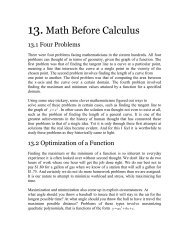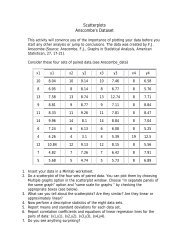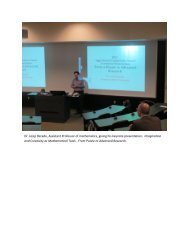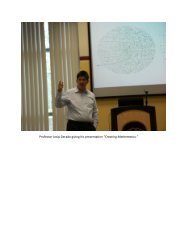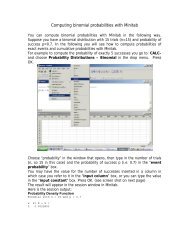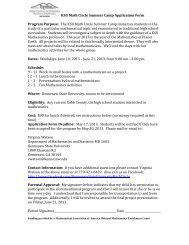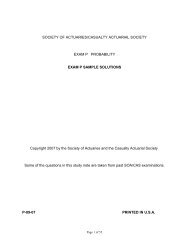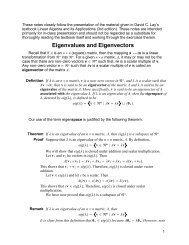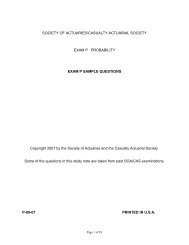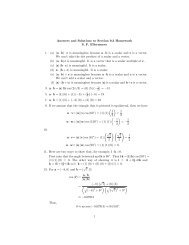P_PracticeExam6_05-1..
P_PracticeExam6_05-1..
P_PracticeExam6_05-1..
Create successful ePaper yourself
Turn your PDF publications into a flip-book with our unique Google optimized e-Paper software.
PRACTICE EXAMINATION NO. 6<br />
! 4 <strong>1.</strong>5 1 $<br />
#<br />
<strong>1.</strong>5 1 0.5<br />
&<br />
#<br />
&<br />
.<br />
" # 1 0.5 1 % &<br />
If a random variable W is defined by the equation X1 = aX2 + bX3 + W and it is uncorrelated<br />
with the variables X2 and X3 then the coefficient a must equal:<br />
A. 1 B. 4<br />
5<br />
7<br />
C. D. 2 E.<br />
3<br />
3 3<br />
Solution.<br />
We have W = X1 ! aX2 ! bX3 , and therefore,<br />
Cov( W , X2 ) = Cov( X1 ! aX2 ! bX3, X2 ) = Cov X1, X2 = <strong>1.</strong>5 ! a ! 0.5b = 0,<br />
Cov( W , X3 ) = Cov( X1 ! aX2 ! bX3, X3 ) = Cov X1, X3 = 1 ! 0.5a ! b = 0,<br />
Hence, 3 ! 2a = 1! 0.5a, so that 2 = <strong>1.</strong>5a, and a = 4<br />
3 .<br />
Answer B.<br />
( ) ! aVar( X2 ) ! bCov X3, X2 ( ) =<br />
( ) ! aCov( X2, X3 ) ! bVar X3 ( ) =<br />
9. A random variable X has the exponential distribution with mean 1<br />
! . Let x ! " be the greatest<br />
integer function, denoting the greatest integer among those not exceeding x. Which of the<br />
following is the correct expression for the expected value of N = ! X"?<br />
! 1 $<br />
A. # &<br />
"<br />
#<br />
! %<br />
&<br />
B.<br />
! 1 $<br />
# &<br />
1<br />
"<br />
#<br />
! %<br />
& "<br />
2<br />
C.<br />
1 1<br />
"<br />
! ! " 2<br />
D. e!<br />
e ! " 1<br />
ASM Study Manual for Course P/1 Actuarial Examination. © Copyright 2004-2007 by Krzysztof Ostaszewski - 263 -<br />
E.<br />
"<br />
e<br />
1<br />
! 1<br />
Solution.<br />
Note that N is a discrete non-negative random variable, so that its expected value can be<br />
calculated as:<br />
( ) = s N<br />
E N<br />
Answer E.<br />
+!<br />
" ( u)du<br />
= $ Pr( N # n)<br />
= $ Pr X<br />
0<br />
+!<br />
n=1<br />
+!<br />
$ = e<br />
n=1<br />
%& + e %2& + ... = e%&<br />
1 % e<br />
= e %&n<br />
+!<br />
n=1<br />
%& =<br />
+!<br />
( ! " # n)<br />
= $<br />
1<br />
e & % 1 .<br />
n=1<br />
Pr( X # n)<br />
=<br />
10. X and Y are independent and both distributed uniformly from 0 to 20. Find the probability



